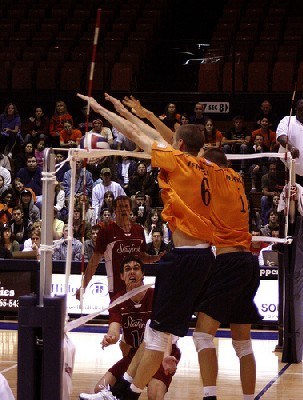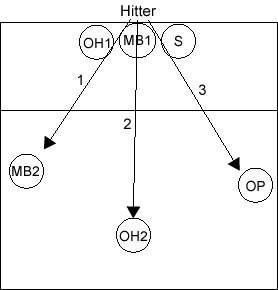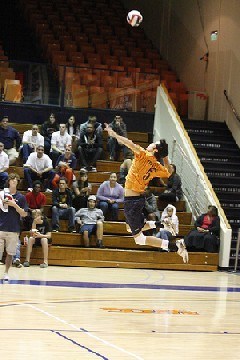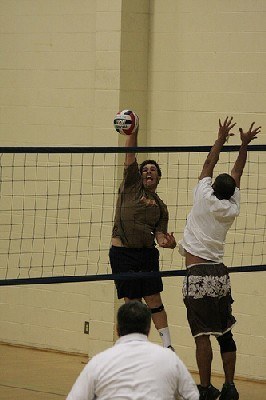Why will these passing techniques make your setter love you? Because they will not be running all over the court to set the pass that was given to them!
Use these techniques and your setter’s life will be a lot easier.
Position
The first key to good passing is proper positioning of the body. Most people think that the key to good passing is in their arms. Actually, the real key is to use the legs first.
The important part of the legs is to use them to move. This sounds simple, but you would be surprised how many people try to pass without moving their legs. The end result is a sloppy pass and your setter will not love you for it. I promised to make them love you, so don’t do that!
When receiving serve or ready to pass, your knees should be bent, you should be on your toes, and ready to move to the ball. Proper passing position would look something like this:
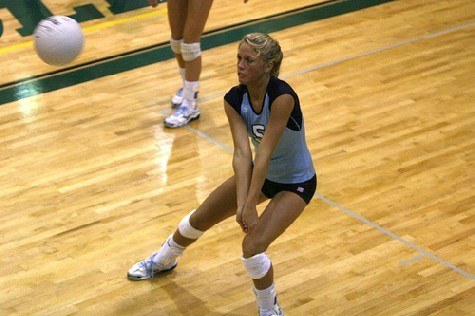 Hands
Hands
The next part of passing techniques to cover are the hands. There are several different methods that people use with their hands. One technique is the cup technique. This is where you lay one hand almost as a cup, put the other hand on top of it, and then fold the thumbs on top of the two hands.
The Best Volleyball Drills To Train Your Team!
These drills are optimized for all team skill levels with variations to keep it fresh and productive. Come see these volleyball drills and learn how to improve your team.
Another method is the fist method. For the fist method, you make a fist with one hand (typically the left hand if you are right handed), the other hand goes around the fist, with the thumbs on top. The thumbs must be side by side on the top.
The other method is to not interlock the fingers/hands at all. Some players will just put their wrists together so that they can pass. I have noticed that the higher level players tend to use this method as they don’t have to worry about putting their hands together when passing.
The important part is to make the hands level/even, so that both arms are even.
Wrists
The important thing to remember is to pull your hands and wrists down towards the ground. In doing so, you are going to expose the flatter part of your forearm to pass with. So, remember to keep your wrists down.
Arms
Your arms are the steering mechanism it is with your arms that you will be guiding the ball to the target. Proper passing techniques say that you should have your hips and arms squared up (facing) your target. This can’t always be done, but the more you can move your feet to the right spot, the easier it will be to square up to the target.
You must use your forearms to pass. The ball should not be hitting your hands/wrists. There are too many bumps in the hands and wrists for there to be any consistent control. If the ball is hitting where your elbows are, you are passing it too high on the arm. Your forearms are the target passing area and you want to keep them as flat as possible for optimum control.
Passing Motion
This is where a lot of beginners make a mistake. Unless you are playing with a bunch of 1st graders that can’t really hit the ball, you are not going to need to swing your arms to get the ball to the setter.
In most cases, there will be enough velocity on the ball (from a serve or a spike) that you will not need to “hit” it to get it to the setter. In fact, when you watch high level players, they hardly move their arms other than pointing the ball to the target as explained above. Let the ball make the impact and point it to the setter.
Here is a good picture of what I mean:
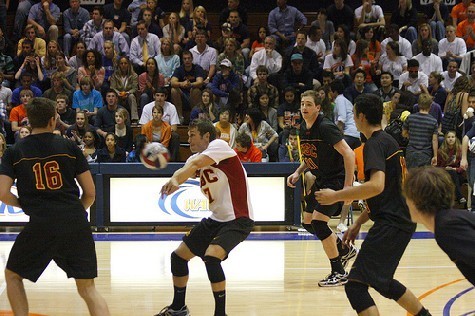
These are the fundamentals of good passing techniques:
* Move your feet to the spot where the ball will be
* Pull your hands/wrists down for a flatter forearm surface
* Square up your hips and arms to the target
* Use your forearms to point the ball to the target
* Don’t swing! Let the velocity of the ball do the work
Follow these rules and you’ll be passing like a pro in no time. In fact, you will look like you are competing for volleyball scholarships! Good passing techniques take a lot of practice, and some patience. The rest is all learned by muscle memory from playing.
Still looking for more, great information on improving your volleyball skills? I highly recommend this book. It is one of the best out there that also includes drills to perfect your technique. Check it out here: Volleyball: Steps to Success
If you liked this page, you might also like the information on the page about volleyball scoring.

